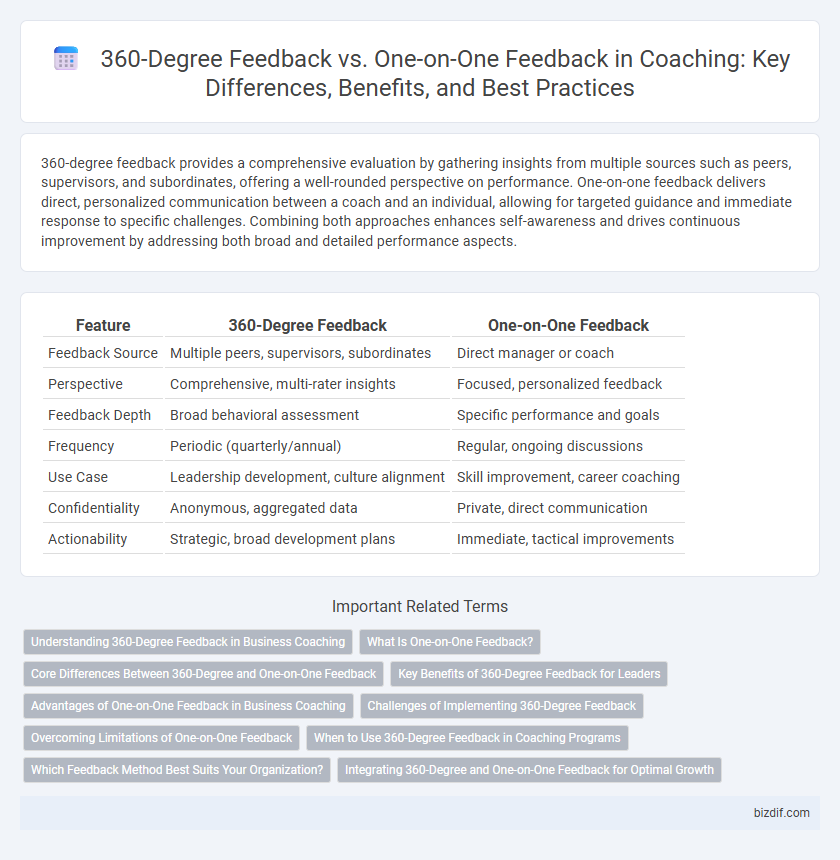360-degree feedback provides a comprehensive evaluation by gathering insights from multiple sources such as peers, supervisors, and subordinates, offering a well-rounded perspective on performance. One-on-one feedback delivers direct, personalized communication between a coach and an individual, allowing for targeted guidance and immediate response to specific challenges. Combining both approaches enhances self-awareness and drives continuous improvement by addressing both broad and detailed performance aspects.
Table of Comparison
| Feature | 360-Degree Feedback | One-on-One Feedback |
|---|---|---|
| Feedback Source | Multiple peers, supervisors, subordinates | Direct manager or coach |
| Perspective | Comprehensive, multi-rater insights | Focused, personalized feedback |
| Feedback Depth | Broad behavioral assessment | Specific performance and goals |
| Frequency | Periodic (quarterly/annual) | Regular, ongoing discussions |
| Use Case | Leadership development, culture alignment | Skill improvement, career coaching |
| Confidentiality | Anonymous, aggregated data | Private, direct communication |
| Actionability | Strategic, broad development plans | Immediate, tactical improvements |
Understanding 360-Degree Feedback in Business Coaching
360-degree feedback in business coaching involves collecting performance insights from multiple sources, such as peers, subordinates, supervisors, and self-assessments, providing a comprehensive view of an individual's strengths and improvement areas. This multi-source feedback enhances self-awareness and fosters holistic development by revealing blind spots and diverse perspectives that one-on-one feedback may miss. Integrating 360-degree feedback into coaching programs promotes more targeted personal growth and aligns individual performance with organizational goals.
What Is One-on-One Feedback?
One-on-one feedback is a personalized communication process where a manager or coach provides direct, specific insights tailored to an individual's performance, skills, and development needs. This feedback format fosters open dialogue, trust, and immediate clarification, enhancing employee engagement and motivation. In contrast to 360-degree feedback, which aggregates input from multiple sources, one-on-one feedback delivers focused, actionable guidance rooted in a singular, authoritative perspective.
Core Differences Between 360-Degree and One-on-One Feedback
360-degree feedback involves collecting performance insights from multiple sources, including peers, subordinates, and supervisors, providing a comprehensive view of an individual's strengths and areas for improvement. One-on-one feedback is a direct, personalized communication between a manager and employee, focusing on specific job performance and development goals. The core difference lies in the scope and perspectives offered, with 360-degree feedback encompassing a broader range of viewpoints compared to the targeted, individualized nature of one-on-one sessions.
Key Benefits of 360-Degree Feedback for Leaders
360-degree feedback offers leaders comprehensive insights by collecting performance evaluations from multiple sources, including peers, subordinates, and supervisors, which enhances self-awareness and highlights blind spots. This multi-rater approach fosters a culture of transparency and accountability, driving targeted personal development and improved leadership effectiveness. Leaders benefit from diverse perspectives that help identify strengths and areas for growth, leading to more informed decision-making and stronger team dynamics.
Advantages of One-on-One Feedback in Business Coaching
One-on-one feedback in business coaching offers personalized insights tailored to individual development needs, fostering deeper trust and open communication between coach and client. This approach enables real-time clarification and immediate application of feedback, enhancing skill acquisition and performance improvement. Confidentiality in one-on-one settings encourages honest self-reflection and facilitates more effective goal alignment.
Challenges of Implementing 360-Degree Feedback
Implementing 360-degree feedback often encounters challenges such as ensuring anonymity to promote honest responses, managing the complexity of gathering and analyzing input from multiple sources, and addressing potential biases that can skew results. Unlike one-on-one feedback, which relies on a direct dialogue between employee and manager, 360-degree feedback demands comprehensive training to interpret the diverse perspectives accurately. Organizations must also overcome resistance to this method by clearly communicating its value and integrating it effectively with existing performance management systems.
Overcoming Limitations of One-on-One Feedback
360-degree feedback enhances coaching effectiveness by incorporating insights from multiple sources such as peers, managers, and direct reports, overcoming the limited perspective of traditional one-on-one feedback. This comprehensive approach reduces bias, uncovers blind spots, and provides a well-rounded view of performance and behavior, fostering more targeted development. By integrating diverse viewpoints, coaches can tailor growth strategies that address broader workplace dynamics rather than isolated interactions.
When to Use 360-Degree Feedback in Coaching Programs
360-degree feedback is most effective in coaching programs when a comprehensive understanding of an individual's performance, behavior, and interpersonal skills is required from multiple perspectives, including peers, subordinates, and supervisors. This approach is ideal for leadership development, team dynamics improvement, and areas requiring holistic growth insights. One-on-one feedback is better suited for addressing specific issues, performance reviews, and more personalized coaching conversations.
Which Feedback Method Best Suits Your Organization?
360-degree feedback offers a comprehensive view by incorporating inputs from peers, subordinates, supervisors, and self-assessments, making it ideal for organizations seeking holistic performance insights and development opportunities. One-on-one feedback fosters personalized, direct communication between managers and employees, best suited for organizations prioritizing timely, specific guidance and relationship building. Choosing the optimal feedback method depends on organizational culture, goals, employee engagement levels, and the need for either broad perspectives or focused, actionable feedback.
Integrating 360-Degree and One-on-One Feedback for Optimal Growth
Integrating 360-degree feedback with one-on-one feedback leverages comprehensive insights from peers, supervisors, and direct reports to create a well-rounded developmental plan. While 360-degree feedback provides a multi-source perspective on strengths and areas for improvement, one-on-one sessions allow for personalized coaching and targeted goal-setting. Combining these approaches enhances self-awareness, aligns expectations, and drives meaningful behavioral change for optimal growth.
360-degree Feedback vs One-on-One Feedback Infographic

 bizdif.com
bizdif.com